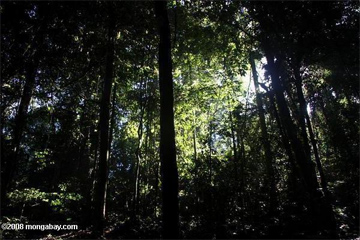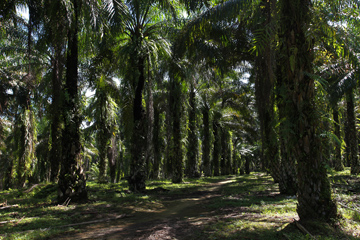
Oil palm and rainforest
Scientists have partnered with one of the world’s largest palm oil producers to measure the impact of converting tropical forest into an oil palm plantation, reports Nature News.
The Stability of Altered Forest Ecosystems project will monitor ecological changes—including biodiversity, erosion, soil quality, carbon dioxide emissions, and water pollution—in roughly 7,000 hectares of forest in the Maliau Basin of Sabah (Malaysian Borneo) as it is logged and planted with oil palms. The experiment, which last at least 10 years, will be funded with 30 million ringgit ($9.8 million) from Sime Darby, a Malaysian palm oil giant.
Imperial College London ecologist Rob Ewers, the project’s scientific director, told Nature News the project aims to find ways to minimize the environmental impacts of palm oil production, including determining the width of riparian zones needed to cut river pollution and how biodiversity fares in forest patches. A highly productive and profitable crop, oil palm has emerged as an important driver of deforestation across Malaysia and Indonesia over the past 25 years.

|
“We want to use the data to optimally design future forest clearance for agricultural income and biodiversity,” Nature News quoted Ewers as saying. “There is always a trade-off. But how can we design the landscape so as to maximize income and minimize environmental costs?”
Ewers told mongabay.com the study has the potential to rival the Brazilian Amazon’s Biological Dynamics of Forest Fragments Project (BDFFP)—the world’s largest-scale and longest-running study of habitat fragmentation—in terms of contributions to scientific knowledge on fragmentation.
“I would hope that Stability of Altered Forest Ecosystems (SAFE) has the potential to exceed the impact of BDFFP, although that will obviously take a considerable amount of time to achieve,” he said via email.
“We’ll create almost four times more fragments than BDFFP, and those fragments are embedded in a larger land use gradient
(primary forest, logged forest, logged and fragmented forest, and oil palm plantation). Also, the fragments are much more isolated than at BDFFP, with the dominant land use around them at large spatial scales being oil palm, whereas at BDFFP the fragments are surrounded at large spatial scales by continuous forest. That wider land use gives us more real-world significance, and working in logged forests in southeast Asia is obviously critical given the paucity of standing forests that have escaped logging.”
Ewers says project’s coordinated research approach will help scientists better understand the processes and mechanisms that cause ecological changes following deforestation and forest fragmentation. It will also give shed light on linkages within the ecosystem, including roles between species and ecological processes.
SAFE researchers have already begun surveying birds in the tract and will begin sampling insects next month. Logging is expected to begin later this year.















